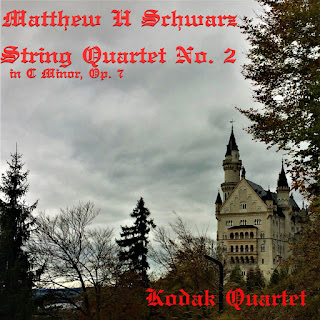Jonathan Ragonese - Concerto for Soprano Saxophone
Jonathan Ragonese -
Concerto for Soprano Saxophone and Wind Ensemble
Jonathan Ragonese, recently appointed director of jazz studies and professor of saxophone at the West Chester University of PA's Wells School of Music, premiered his own fifteen-minute concerto composed for himself on soprano saxophone and the university's wind ensemble. The ensemble, under the regimented baton of Dr. Andrew Yozviak, is incredibly well-accomplished for a mostly undergraduate group, with previous performances in several major venues and multiple premieres of faculty works. Ragonese's Concerto (listen and watch the full performance here) takes the form of three movements, in the standard order of fast - slow - fast, with an Interstice starting the work and separating each of the movements. The soprano saxophone is tacet during each of these Interstices, as they each act as a breath of calm prior to each movement. Ragonese titles the movements using historically traditional musical jargon: Ricecar, Passacaglia, and Quodlibet, respectfully. Despite these references, and slight nods to the source definition, the overall aesthetic of the Concerto is focused on combining the now-standard "wind band" sound of the late twentieth century with multiple new music applications of such a versatile solo instrument.
The dissonant chorale which comprises Interstice 1.0 begins with the chanting of four solo woodwinds. In classical rhetorical fashion, the phrase plays four times, with the third variation inflected and the fourth a hollow, questioning shell of its former self. The rhetorical figure immediately continues through into the first movement, with three loud awakening ensemble stabs preceding the multiphonic entrance of the solo soprano saxophone. Ragonese's surprising choice of a multiphonic timbre as the first sound created by the soloist is a risky, yet effective decision. The crackle of extended technique instantly separates the saxophone soloist from the rest of the ensemble, and is successful in allowing the saxophone, a timbre we have all subconsciously associated with band music, to shine through the entirety of the wind ensemble. Ricecar continues on in a flurry of fast, technical runs for the soloist, and lots of noisy percussion and low brass hits from the ensemble. This movement is meant to show off Ragonese's own technical command of a notorious beast of the small instrument. The wild runs up and down the entire range of the instrument are reminiscent of wild be-bop solos from the composer's initial jazz background. While the remainder of this movement is not incredibly interesting from an ensemble point, it sounds like standard run-of-the-mill wind band music, the composer achieves what he desired, to show off in front of a large audience.
I found the second and third movements to be much more impressive than the first from a compositional standpoint. Interstice 1.1 sounds like corny ringtones going off from the pitched percussion in the back of the ensemble, and here Ragonese gets a chance to show off his academic intellect by using the original interstice melody overtop a prediction in the low marimba of the descending bass passacaglia from the next movement. The only aspect of the Passacaglia which does not work for me is the very opening unaccompanied euphonium solo. As heard in a multitude of recent wind band pieces, such as the symphonies of David Maslanka, composers, especially young composers, tend to gravitate toward the euphonium as a soloistic voice. However as we hear, the instrument in never incredibly reliable to use unaccompanied in large ensembles. It also seems to be a specific weakness of Ragonese to not orchestrate incredibly practically, forcing the performers and conductor to put in a lot of extra work into balancing the ensemble. Despite all of this, principal euphonium player, Issac Sattazahn, does a terrific job making this solo sound as natural as possible. The rest of the movement is a truly beautiful ballad, with Ragonese again calling upon his jazz background to create gorgeous brass swells from the ensemble. Passacaglia ends with a final, sustained note in the low winds and brass, decaying into nothingness.
By the third interstice, Interstice 1.2, we begin the understand what Ragonese is compositionally attempting. This time he allows the brass soloists to come to the forefront, the last of the sections to be shown off in one of these awkward interludes. Interstice 1.2 is incredibly similar to 1.0, using the same chorale material but this time resolving into consonance rather than dissonance. Quodlibet, the third and final movement, sounds to me as Ragonese parodying the second movement "Felt" from John Mackey's Concerto for Soprano Saxophone and Wind Ensemble. With being one of the only other major works in this genre of soprano saxophone and wind ensemble, the quotation beginning with Ragonese's first entrance seems hardly coincidental. Just as a true, old-fashioned quodlibet, Ragonese takes operatic and popular tunes (or at least popular tune sounding melodies) and layers them one by one overtop of each other. The ensemble clearly has the most fun during this movement, as it allows the full band to come together and actually play melodic ideas for the first time throughout the entire work. The overall crazy impression created by this is only furthered when the whole concerto abruptly stops in its tracks, almost literally knocking the audience over from the cessation of forward momentum. The only sounds heard are Ragonese clutching one final gruesome multiphonic, which slowly dies away with the resonance of the metallic percussion.
Overall, Ragonese's Concerto for Soprano Saxophone was an incredibly fun work to listen to as a saxophone show piece, but I truly doubt it will continue into the standard repertoire. The interjections, sorry interstices, seem out of place and serve very little purpose besides forcing space between each movement. I would have also appreciated it if the composer planned out and used the wind ensemble idiom more effectively, rather than just solely as accompaniment for his technically demanding runs and virtuosic performance.
originally written and published 22 Nov. 2021



Comments
Post a Comment